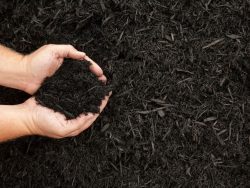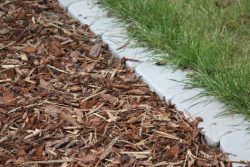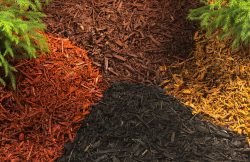Mulching, put simply, is the practice of adding composted material to your garden beds to help with weed suppression, plant fertility, water retention, and more. It comes in multiple varieties, each with its own pros and cons.
However, because homemade mulch is generally made up of leaves, wood, and other biological materials – exactly the kinds of materials that people generally rake out of their beds – many homeowners are struggling to find ways to mulch their beds and simultaneously keep them looking fresh, consistent, and pristine.

Why Mulch is a Benefit?
First, we need to understand how and why mulching can potentially be a huge benefit to your landscape. In terms of plant health, the benefits of having a layer of mulch installed into the garden beds of your landscape are virtually endless.
When installed properly, mulches can…
- Suppress weed growth
- Slow the evaporation of water, allowing for greater retention in garden beds
- Help fertilize plants
- Regulate ground temperature and plant health during cold/warm seasons
- Prevent washouts and erosions
- Look great
Many people use homemade mulches – fallen leaves, home compost, grass clippings, sawdust, green waste, and more – as a means of mulching their gardens.
Though these practices can certainly be effective, they tend not to look as nice or last as long as other alternatives. So, what are these alternatives, and how can you mulch in a way that preserves the look and function of your landscape?

The advantages (and disadvantages) of different types of mulch
Mulch can be differentiated from conventional garden blend soils and topsoils by its composition and sand content. It’s composed entirely of compostable materials, like bark, wood, and organic matter. Soils for gardens, however, actually contain around 25% sand, which helps with proper drainage.
For that reason, garden beds should never be comprised entirely of mulch. For proper drainage and the health of your plant’s roots, mulch should only be installed as a 2-4 inch topdressing atop an appropriate topsoil or garden blend.
Let’s take a look at some common types of mulch you can find around Vancouver:
Composted mulch
A common option available at most bulk retailers around Vancouver, black composted bark mulch is an excellent option for topdressing garden beds.
It’s comprised entirely of green waste (leaves, sticks, grass clippings, and old soil) that has fully decomposed and turned a rich black colour, making it almost indistinguishable from many soils (at a glance).

Pros
- In terms of plant health and weed suppression, composted mulch is unbeatable.
- A very environmentaly friendly and sustainable option.
Cons
- It needs to be re-applied every 1-2 years
- May not be as aesthetically pleasing to many homeowners who prefer the distinct look of bark mulches.
Aged bark mulch
Aged bark mulch contains around 90% tree bark and 10% compost. Because it’s so rich in nutrients, it’s an excellent choice for nearly any garden application.

Pros
- Heavy enough that it’s unlikely to blow away in strong winds.
- It is quite absorbent, enough so that it’s unlikely to wash away in heavy rainfall.
- Aged bark looks unique and gorgeous.
Cons
- It needs to be reapplied once every 1-2 years since it eventually breaks down.
- Less ideal for pathways and non-garden applications.
Fir bark mulch
Fir bark mulch is soft and light in both colour and weight. Though it can (and likely will!) work well in your garden bed, some fir mulches aren’t ground finely enough to work as an organic mulch.

Pros
- Due to fir’s natural water-resistance, it can be very long lasting in comparison to other mulches.
- Distinct and attractive red colour ideal for garden aplications.
- Keeps roots cool and prevents weeds.
Cons
- If the bark chips are too large (2 or more inches in length), it’s perhaps a more appropriate choice for walking paths and playgrounds.
Dyed bark mulch
If you purchase from the right supplier, dyed mulches (which generally come in yellow, red, brown, and black) are harmless and have the potential to be as effective as any other. However, be careful, some cheaper options use cheaper dyes, which can bleed into the ground and cause tons of problems.

Pros
- Can add a unique pop of colour to your landscape.
- Promotes plant health and weed prevention
Cons
- Can potentually give an unnatural look to a landscape.
- Impropper sourcing risks dyes leaching into groundwater and plants.
Our advice? Don’t risk it! If you want to inject a pop of colour into your landscape, choose a more natural-looking method – like planting some colourful shrubs, trees, or perennials instead.
The risks of mulching
No matter what type you choose, it’s very important you properly apply it in a layer 2-4 inches thick
If you mulch too thinly:
- Weed suppression, temperature regulation, and washout prevention will be rendered ineffective.
- Your landscape may look mismatched and uneven as the mulch erodes/decomposes.
If your mulch is too thick:
- The ground can become too warm in the summer, meaning it’s possible that your plants won’t be able to take in enough water, or they’ll simply overheat and die.
- Wet, thick mulch that sits against the stems or trunks of plants can cause rot to form
- Small animals and rodents may make nests in it
What can we do?
If you’re uncertain how, why, when, where, and/or what to mulch, please get in touch! Our trained, knowledgeable Landscape Services division can quickly handle even large-scale soil and mulch installations. You can rest easy knowing that we’ll apply layers of even thickness that will benefit your plants for years.
Get in touch for a consultation!


Comments are closed here.